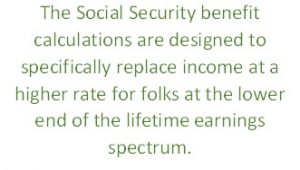 During your career you may have worked for a governmental agency or a foreign employer where there was no Social Security tax withheld from your earnings (Job A). At the same time or at some other point, you may also have worked in a job that was covered by Social Security (Job B). The end result is that now you’re ready to retire, and you will collect a pension from Job A, and you’re also eligible to collect Social Security benefits based on Job B. But the Social Security benefits are being reduced because of something called WEP – Windfall Elimination Provision. Why is this WEP even in existence?
During your career you may have worked for a governmental agency or a foreign employer where there was no Social Security tax withheld from your earnings (Job A). At the same time or at some other point, you may also have worked in a job that was covered by Social Security (Job B). The end result is that now you’re ready to retire, and you will collect a pension from Job A, and you’re also eligible to collect Social Security benefits based on Job B. But the Social Security benefits are being reduced because of something called WEP – Windfall Elimination Provision. Why is this WEP even in existence?
You’ve probably heard that this provision prevents “double-dipping” in retirement benefits from two systems. That’s true, but it doesn’t really explain why WEP is a factor for many retirees. In order to understand why WEP even exists we need to understand how Social Security works.
PIA calculation
As explained in other articles on this site, your Social Security benefit is calculated by determining your Primary Insurance Amount, or PIA. Your PIA is the basis for determining your Social Security benefit amount at various ages. If you file for Social Security retirement benefits at your Full Retirement Age (FRA), your benefit amount will equal to the PIA. If you file before FRA, the benefit will be less; filing after FRA results in a higher benefit above the PIA.
The PIA derives from another figure, known as the Average Indexed Monthly Earnings, or AIME – which is effectively your average earnings over your top 35 years of earnings in your career, with an index applied.
Once you know what your AIME figure is, bend points are applied to calculate your PIA. Let’s say Janice has an AIME of $6,000 and she reached 62 in 2020. For Janice, the bend points are $960 and $5,785. And, if WEP is not involved, her PIA is calculated as follows:
The first $960 of the AIME is multiplied by 90%: $960 X 90% = $864
The amount of Janice’s AIME that is greater than $960 but less than or equal to $5,785 is multiplied by 32%: $5,785 – 960 = $4,825 X 32% = $1,544
The amount of AIME that is above $5,785 is then multiplied by 15%: $6,000 – $5,785 = $215 X 15% = $32.25
These three results are then added together, producing Janice’s PIA: $864 + $1,544 + $32.25 = $2,440.25, rounded down to $2,440.20.
Similarly, if Andrea’s AIME was $2,000, the calculation would go like this:
$960 X 90% = $864
$2,000 – $960 = $1,040 X 32% = $332.80
None of Andrea’s AIME was above $5,785, so the third is zero.
Adding together, we get Andrea’s PIA of $864 + $332.80 + $0 = $1,196.80
Now, I didn’t bring you here to work through math problems, there’s actually a point to all of this. Look at the two figures we came up with in the two examples above. From Janice’s $6,000 AIME, we produced a PIA of $2,440.20, while from Andrea’s $2,000 AIME, we produced a PIA of $1,196.80.
Janice’s PIA is 40.67% of the AIME, while Andrea’s PIA is 59.84% of the AIME. This means that Andrea’s potential Social Security benefit will replace almost 50% more of her income as opposed to the rate that Janice’s Social Security benefit will. True, Janice still has the higher benefit coming to her, but she earned 3X as much over her lifetime than Andrea did (and therefore paid in 3X as much tax).
This is a quick illustration of how Social Security prioritizes benefit replacement at lower levels of average lifetime income. The lower your AIME over your lifetime, the greater percentage of your pre-retirement income will be replaced by Social Security benefits. If your AIME was exactly (or less than) $960, you would expect a PIA of 90% of your AIME.
At the other end of the spectrum, the more you earn over your lifetime, the less your pre-retirement income will be replaced by Social Security. Once your AIME goes above the second bend point (in this case, $5,785), each additional dollar added to the average for your lifetime will only increase your PIA by 15 cents.
We’re not here to argue whether or not this is fair, just to explain how the system works. The Social Security benefit calculation is specifically designed to be weighted toward greater income replacement at the lower income levels, and far lower income replacement as average income increases.
Enter non-Social Security-taxed earnings
Now that we have a handle on how Social Security benefits are calculated in the normal circumstances, let’s add a new wrinkle to the picture: what if the individual had earnings from a non-Social Security-taxed job in the mix?
Let’s say we have Lucy, also turning 62 in 2020, who also has an AIME that is $2,000 – but Lucy didn’t produce this relatively low AIME by working in lower paying jobs. She produced this AIME because she had worked in non-Social Security-taxed jobs for most of her career, and then at the end of her career she worked in the private sector, just long enough to produce the proper number of Social Security credits to qualify for benefits (40 quarters, or 10 years). Since the AIME is calculated based on your top 35 years of earnings, and Lucy only has 10 years of earnings, her AIME is considerably low by comparison to the actual earnings. She was actually earning pretty high income during those 10 years, but the averaging mechanism brings down the AIME. If not for WEP, Lucy could wind up with the same PIA as Andrea – even though she only participated in the Social Security system for only 10 years and the rest of her career her income was not subject to Social Security taxation.
This is a quandry – it’s not right that Lucy should get the same benefit as Andrea. After all, Lucy is also collecting a pension from her non-SS-taxed job on top of the Social Security benefit. True, Lucy should get some Social Security benefit, but her income replacement level for those 10 years of earnings should not be at the upper end of the spectrum as Andrea’s are.
WEP addresses this problem by reducing the first bend point multiplier. In the case of Lucy, the first bend point is reduced to 40% (instead of 90%). The other multipliers remain the same, because the main thing the provision is addressing is the lowest levels of income replacement. So here’s how Lucy’s PIA is calculated:
40% of the first bend point: $960 X 40% = $384
32% of the second: $2,000 – $960 = $1,040 X 32% = $332.80
None of her AIME is above $5,785: $0
Adding them all together, we get $384 + $332.80 + $0 = $716.80
So Lucy’s income replacement from Social Security is 35.84%, while Andrea’s was nearly 60%. This is how and why WEP works the way it does.
Making it fair
There are a few situations when strict application of the WEP calculations is unfair to the benefit recipient. For one, if the individual has earned within the Social Security system alongside the non-covered job for many years, the WEP calculation penalizes this person unfairly. Additionally, if the pension or Social Security benefit is small, the WEP calculation unduly penalizes the individual as well.
So what if Lucy’s $2,000 AIME was produced over 35 years of side-jobs instead of over the relatively short 10-year timeframe illustrated above? Assuming that those 35 years of earnings were “substantial” by Social Security’s definition, then the WEP impact would be eliminated from her PIA calculation, and Lucy would have the exact same PIA as Andrea. She’d collect that amount plus her pension from the non-covered job. For more details on how this works, see this article about substantial earnings.
On the other hand, what if Lucy’s pension from the non-covered job was somewhat low? What if, for example, Lucy worked in the governmental job for 10 years, then raised her children for 20 years, during which she didn’t earn any outside income, and then after the kids were all in high school she went back to work over the intervening 10 years in a Social Security covered job?
In a case like this, assuming that the pension earned from the non-covered job is relatively small, there is a limitation on the impact that WEP can apply to Lucy’s PIA. If her pension from the non-covered job was, for example, $500 a month, then the WEP reduction is limited to half of the amount of the pension. Everything else remaining the same from the earlier example, Lucy’s PIA would be calculated as:
40% of the first bend point is $384; this is a reduction of $480 from the original bendpoint rate of 90%, therefore, this reduction is capped at 50% of her pension amount, or $250. The resulting first bend point is $864 – $250 = $614.
32% of the second bend point: $332.80
None of the AIME is above $5,785: $0
Adding together, Lucy’s PIA is now $614 + 332.80 + $0 = $946.80. This is an income replacement rate of 47.34% – still less than Andrea’s, but not as low as when Lucy’s pension is larger.
Likewise, if the original (non-WEP-impacted) PIA is relatively low, there is another cap put in place to ensure that WEP doesn’t reduce the PIA to an amount less than 50% of the original PIA (before WEP). So, if Maria, who also worked in a non-SS-covered job for most of her career, but only earned enough in SS-taxed jobs to produce an AIME of $800, her PIA would be calculated like this:
Original PIA calculation is: 90% X $800 = $720. 50% of that amount is $360; WEP applied is 40% X $800 = $320. Since $320 is less than half of the “original” PIA calculation, the default is $360, 50% of the original PIA.
None of the AIME is above $960 or $5,785, so $0 and $0.
Maria’s PIA is $360 + $0 + $0 = $360. This is a replacement rate of 45% of Maria’s AIME of $800.
The point
The point of all of this is to explain why the WEP provision exists in the first place. Social Security was never designed to provide the same amount of income replacement to all individuals participating in the system. The Social Security benefit calculations are designed to specifically replace income at a higher rate for folks at the lower end of the lifetime earnings spectrum.
When an individual only participates in the Social Security system for a relatively short period of time, the average earnings are artificially lower due to the averaging method. If this is because he or she was working in a non-covered job for the rest of his or her career, the benefit calculation would give this individual a high income replacement based on this artificially low average income. WEP provides a method to adjust the benefit calculation so that income replacement is more appropriate to the circumstances.














 During your career you may have worked for a governmental agency or a foreign employer where there was no Social Security tax withheld from your earnings (Job A). At the same time or at some other point, you may also have worked in a job that was covered by Social Security (Job B). The end result is that now you’re ready to retire, and you will collect a pension from Job A, and you’re also eligible to collect Social Security benefits based on Job B. But the Social Security benefits are being reduced because of something called WEP –
During your career you may have worked for a governmental agency or a foreign employer where there was no Social Security tax withheld from your earnings (Job A). At the same time or at some other point, you may also have worked in a job that was covered by Social Security (Job B). The end result is that now you’re ready to retire, and you will collect a pension from Job A, and you’re also eligible to collect Social Security benefits based on Job B. But the Social Security benefits are being reduced because of something called WEP – 






 Sterling Raskie, MSFS, CFP®, ChFC®
Sterling Raskie, MSFS, CFP®, ChFC® The latest in our Owner’s Manual series, A 401(k) Owner’s Manual, was published in January 2020 and is available on
The latest in our Owner’s Manual series, A 401(k) Owner’s Manual, was published in January 2020 and is available on  A Medicare Owner’s Manual, is updated with 2020 facts and figures. This manual is available on
A Medicare Owner’s Manual, is updated with 2020 facts and figures. This manual is available on  Social Security for the Suddenly Single can be found on Amazon at
Social Security for the Suddenly Single can be found on Amazon at  Sterling’s first book, Lose Weight Save Money, can be
Sterling’s first book, Lose Weight Save Money, can be  An IRA Owner’s Manual, 2nd Edition is available for purchase on Amazon. Click the link to choose the
An IRA Owner’s Manual, 2nd Edition is available for purchase on Amazon. Click the link to choose the  Jim’s book – A Social Security Owner’s Manual, is now available on Amazon. Click this link for the
Jim’s book – A Social Security Owner’s Manual, is now available on Amazon. Click this link for the  And if you’ve come here to learn about queuing waterfowl, I apologize for the confusion. You may want to discuss your question with Lester, my loyal watchduck and self-proclaimed “advisor’s advisor”.
And if you’ve come here to learn about queuing waterfowl, I apologize for the confusion. You may want to discuss your question with Lester, my loyal watchduck and self-proclaimed “advisor’s advisor”.